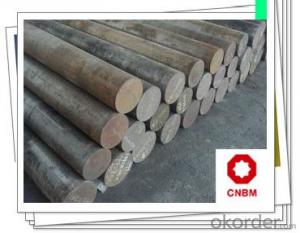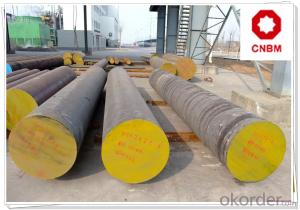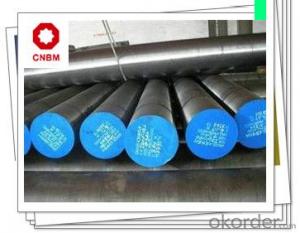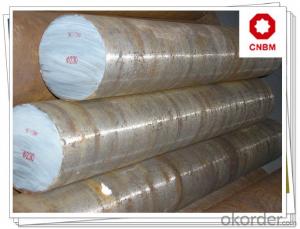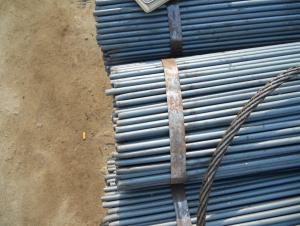45# Carbon Steel Material
- Loading Port:
- Shanghai
- Payment Terms:
- TT OR LC
- Min Order Qty:
- 30 m.t.
- Supply Capability:
- 120000 m.t./month
OKorder Service Pledge
OKorder Financial Service
You Might Also Like
45# Carbon Steel Material
Product Description
Chemical Composition | Mechanical Properties (In Quenched & Tempered State) | ||
C | 0.42-0.50 % | Tensile strength(MPA) | ≥600 |
Si | 0.17-0.37 % | Yield strength (MPA) | ≥355 |
Mn | 0.50-0.80 % | Elongation (δ5/%) | ≥16 |
Cr | ≤0.25 % | Reduction in Area (ψ/%) | ≥40 |
Ni | ≤0.25 % | Impact (J) | ≥ 39 |
P | ≤0.035 % | Hardness | ≤197HB |
S | ≤0.035 % | ||
Cu | ≤0.25 % | ||
1, Diameter: 8mm-250mm rounds
5mm-9mm rods
2, Length: 2m, 3m, 5.8m, 6m or customized
3, Standard: GB, ASTM, AISI, SAE, DIN, JIS, EN
OEM technology - send detailed technical parameters for accurate quotation.
2, Produce Process: smelt iron - EAF smelt billet - ESR smelt billet -
hot rolled or forged to get the steel round bar and plate
3, Heat Treatment: annealing, normalizing, tempering, quenching
4, Surface Treatment: Black, Polished, Galvanized
5, Quality Assurance: We accept third party inspection for all orders.
You can ask testing organizations such as SGS, BV, etc. to test our products before shipping.
Products Show
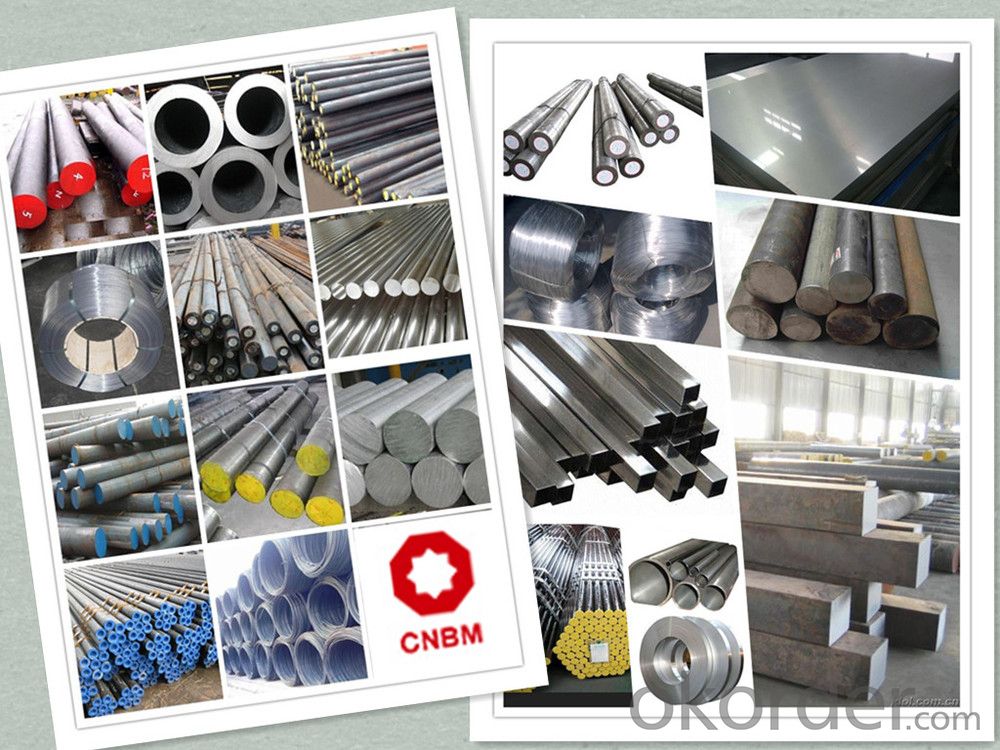
Product Overviews
| Product Name | Typical Grades | Diameter(mm) | Standard adopted |
| Carbon Steel | 20 (1020/S20C/C22) | Ø16-Ø300 |
GB/SAE/JIS/DIN
|
| 40 (1040/S40C/C40) | |||
| 45 (1045/S45C/C45) | |||
| Bearing Steel | GCr9 (51100/SUJ1) | Ø12-Ø250 | |
| GCr15 (52100/SUJ2/100Gr6) | |||
| GCr9SiMn (A485-Gr.1/SUJ3) | |||
Cr-Mo Steel | 20Cr (5120/SCr420H/20Cr4) | Ø12-Ø250 | |
| 40Cr (5140/SCr440/41Cr4) | |||
| 42CrMo(4140/SCM440/42CrMo4) | |||
| Gear Steel | 20CrNiMo | Ø16-Ø600 | |
| 20CrMn(5115/SMnC420/20MnCr5) | |||
| 20CrNiMo(8620/SNCM220/20CrMiMo2) |
Work Shop

Company Information
CNBM International Corporation is the most important trading platform of CNBM group.
Whith its advantages, CNBM International are mainly concentrate on Cement, Glass, Iron and Steel, Ceramics industries and devotes herself for supplying high qulity series of refractories as well as technical consultancies and logistics solutions.

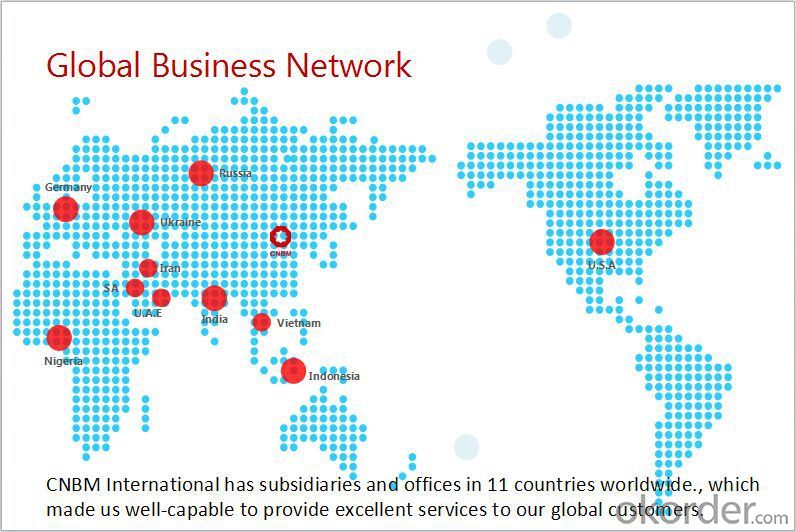
FAQ
1, Your advantages?
professional products inquiry, products knowledge train (for agents), smooth goods delivery, excellent customer solution proposale
2, Test & Certificate?
SGS test is available, customer inspection before shipping is welcome, third party inspection is no problem
3, Factory or Trading Company?
CNBM is a trading company but we have so many protocol factories and CNBM works as a trading department of these factories. Also CNBM is the holding company of many factories.
4, Payment Terms?
30% TT as deposit and 70% before delivery.
Irrevocable L/C at sight.
5, Trading Terms?
EXW, FOB, CIF, FFR, CNF
6, After-sale Service?
CNBM provides the services and support you need for every step of our cooperation. We're the business partner you can trust.
For any problem, please kindly contact us at any your convenient time.
We'll reply you in our first priority within 24 hours.
Packaging & Delivery
1, Packaging: seaworthy package or as required
2, Delivery: 35-45 days or based on quantity
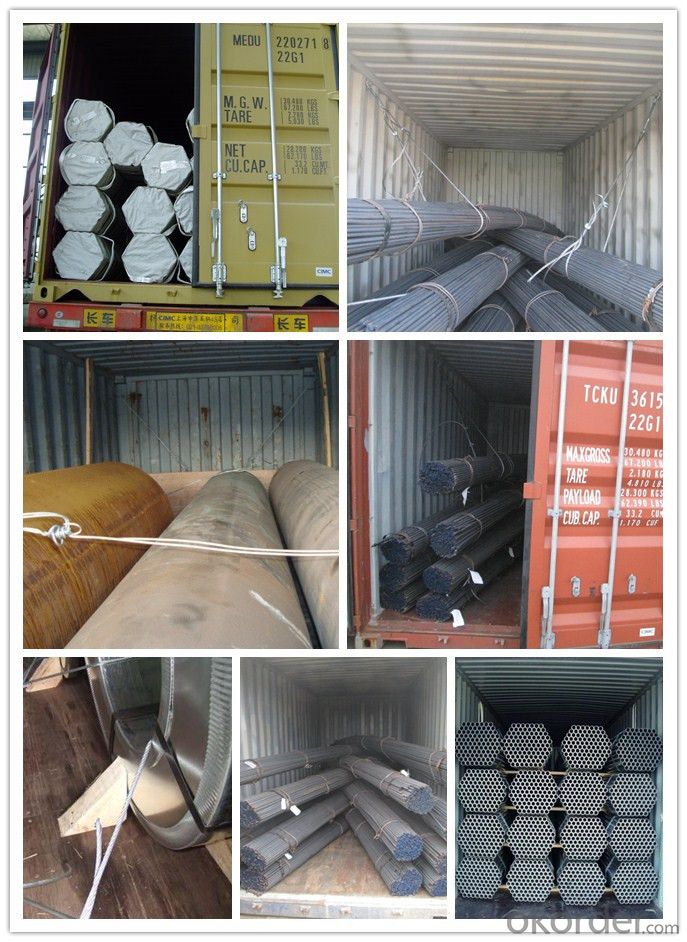
- Q:Can steel round bars be hardened and tempered?
- Yes, steel round bars can be hardened and tempered. Hardening and tempering are heat treatment processes used to increase the hardness and strength of steel. To harden a steel round bar, it is heated to a high temperature and then rapidly cooled, typically by quenching in water, oil, or air. This process transforms the steel's structure, making it harder and more brittle. Once the steel round bar has been hardened, it is often too brittle for many applications. To reduce the brittleness and improve its toughness, the hardened steel is then tempered. Tempering involves reheating the steel to a specific temperature and holding it at that temperature for a specified time before allowing it to cool naturally. This process allows the steel to partially soften and relieve internal stresses, making it tougher and more ductile. The hardness and tempering temperature can be adjusted to achieve the desired mechanical properties for different applications. The hardening and tempering process can be used to produce steel round bars with varying levels of hardness, strength, and toughness to suit specific engineering requirements.
- Q:How do you calculate the length of a steel round bar?
- To calculate the length of a steel round bar, measure the distance from one end to the other using a ruler, tape measure, or any other measuring tool.
- Q:How are steel round bars tested for quality and strength?
- To ensure that steel round bars meet the necessary standards and specifications, various methods are employed to test their quality and strength. One commonly used test is the tensile test, which measures the bar's ability to withstand tension. In this test, a sample of the steel bar is gradually loaded until it reaches its breaking point, and the maximum load it can handle is recorded, along with the sample's elongation and reduction in area. These values offer valuable insights into the bar's strength and ductility. Another test employed is the hardness test, which assesses the steel bar's resistance to indentation or penetration. This test utilizes a hardness testing machine that applies a specific force to a small indenter, such as a diamond or a steel ball, and measures the resulting indentation's depth or size. The obtained hardness values can indicate the bar's strength and its ability to withstand wear and deformation. Apart from these mechanical tests, non-destructive testing methods are also used for steel round bars. Ultrasonic testing is a common technique employed to identify internal defects or inconsistencies in the bar's structure. This method involves transmitting high-frequency sound waves through the bar and analyzing the reflected waves to detect any irregularities. Magnetic particle inspection is another non-destructive test that relies on magnetic fields and particles to identify surface or near-surface defects in the steel bar. Chemical analysis plays a crucial role in determining the quality of steel round bars. This analysis involves testing the steel's composition to ensure it meets the required chemical specifications. It helps identify the presence of impurities or elements that could impact the bar's performance and durability. In summary, steel round bars undergo a combination of mechanical, non-destructive, and chemical tests to evaluate their quality and strength. These tests provide manufacturers with essential information, enabling them to ensure that the bars meet the necessary standards and are suitable for their intended applications.
- Q:Difference between round bar and threaded steel in use.
- Because the surface has a thread shape, it can increase the firm bond with the concrete. The longitudinal reinforcement and stirrups shall be used preferentially in the concrete members.
- Q:What are the different grades of steel used in round bars?
- The different grades of steel used in round bars vary depending on the desired properties and applications. Some common grades include mild steel (low carbon steel), stainless steel, alloy steel, and tool steel. Each grade offers specific characteristics such as strength, corrosion resistance, hardness, or machinability, allowing for a wide range of applications in industries like construction, manufacturing, automotive, and aerospace.
- Q:What are the different types of steel round bar surface defects?
- Steel round bars can exhibit various types of surface defects. Among the most common defects are: 1. Scale: This defect arises from the formation of a thin layer of oxide on the steel's surface during manufacturing. It presents as a rough, flaky, or scaly texture and can be easily eliminated through pickling or abrasive cleaning. 2. Pitting: Localized corrosion manifests as small, shallow holes or depressions on the steel's surface. It is usually caused by exposure to corrosive substances or environments and can weaken the material if left unaddressed. 3. Surface cracks: These visible cracks appear on the surface of the steel round bar and can be attributed to factors like improper cooling during manufacturing, excessive stress, or mishandling. Surface cracks can compromise the steel's structural integrity and necessitate careful inspection and repair. 4. Decarburization: This defect occurs when the steel's surface layer loses carbon content, resulting in reduced hardness and strength. High temperatures during heat treatment or inadequate cooling methods often cause decarburization. It can be identified through visual inspection or hardness tests. 5. Lamination: Lamination defects arise when layers or flakes are present within the steel round bar. These layers can weaken the material and compromise its structural integrity. Improper rolling or excessive impurities in the steel are typically responsible for lamination defects. 6. Inclusions: During the manufacturing process, foreign materials or impurities can become trapped within the steel, resulting in inclusions. These can appear as dark spots, streaks, or irregular shapes on the round bar's surface. Inclusions reduce the steel's strength and ductility and can be caused by factors such as poor raw material quality or insufficient refining processes. It is crucial to note that the severity and impact of surface defects on steel round bars can vary. Regular inspection and quality control measures are essential for identifying and rectifying any surface defects, ensuring the reliability and integrity of the steel round bar.
- Q:What are the cost considerations for steel round bars?
- The cost considerations for steel round bars typically include factors such as the grade and quality of steel used, the diameter and length of the bar, the quantity being purchased, and the current market conditions. Additionally, any additional processing, such as cutting or heat treatment, may also affect the overall cost.
- Q:Are steel round bars suitable for electrical applications?
- Steel round bars can be suitable for electrical applications depending on the specific requirements and conditions. Steel is known for its excellent conductivity, strength, and durability, making it a popular choice for various electrical applications. However, it is important to consider a few factors before using steel round bars in electrical applications. First, steel is a good conductor but not as good as other materials like copper or aluminum. Consequently, its use in electrical applications may result in higher resistance and energy loss compared to these more conductive materials. Additionally, steel round bars may be prone to corrosion, especially in humid or corrosive environments. This can affect the overall performance and longevity of the electrical system. In such cases, proper insulation or protective coatings may be necessary to prevent corrosion and ensure the reliability of the electrical application. In summary, while steel round bars can be suitable for electrical applications due to their conductivity, strength, and durability, it is essential to consider factors such as conductivity, corrosion resistance, and overall system requirements before utilizing them.
- Q:How do you determine the hardness of a steel round bar?
- There are various methods available to determine the hardness of a steel round bar. One commonly used method is the Rockwell hardness test, where a minor load is applied to the bar's surface using a diamond or hardened steel ball, followed by a major load. The depths of penetration for both loads are measured, and the hardness value is determined based on the difference between these depths. Another method is the Brinell hardness test, which involves indenting the steel bar's surface using a hardened steel ball under a specific load. The resulting indentation's diameter is measured, and the hardness value is calculated based on the load and indentation diameter. Alternatively, the Vickers hardness test can also be utilized. This test employs a diamond pyramid-shaped indenter applied to the steel bar's surface under a specific load. The size of the indentation is measured, and the hardness value is determined based on the load and indentation's surface area. It's important to consider that the choice of method depends on factors such as the steel type and desired accuracy of the measurement. Moreover, other factors like heat treatment and composition can impact the steel bar's hardness, so they should be taken into account during hardness determination.
- Q:What are the different types of steel round bar alloys used in the automotive industry?
- Different types of steel round bar alloys are utilized in the automotive industry for their distinct properties and applications. 1. Carbon Steel: Carbon steel round bars are extensively employed due to their favorable attributes of strength and toughness. They find use in various automotive components like axles, crankshafts, and gears. 2. Alloy Steel: Alloy steel round bars comprise additional alloying elements such as chromium, nickel, or molybdenum. These alloys enhance the mechanical properties of the steel, rendering it stronger and more durable. Automotive applications like suspension components, drive shafts, and steering components commonly employ alloy steel round bars. 3. Stainless Steel: Automotive applications that demand durability in harsh environments benefit from the highly corrosion-resistant nature of stainless steel round bars. Exhaust systems, fuel tanks, and body parts are frequently made using stainless steel. 4. Tool Steel: Tool steel round bars exhibit high hardness, wear resistance, and toughness. They are predominantly used in the production of automotive tools and dies, like punches, dies, and cutting tools. 5. Bearing Steel: Bearing steel round bars are specifically designed to offer excellent wear resistance and high load-carrying capacity in automotive bearings. These bars possess a high level of hardness and undergo heat treatment to ensure optimal performance. 6. Spring Steel: Automotive suspension systems and other applications that necessitate exceptional elasticity and fatigue resistance utilize spring steel round bars. These bars are capable of enduring repeated stress while maintaining their shape, making them ideal for automotive springs and stabilizer bars. It is crucial to consider the desired properties, performance requirements, and cost considerations of each automotive component when selecting a specific steel alloy.
1. Manufacturer Overview |
|
|---|---|
| Location | |
| Year Established | |
| Annual Output Value | |
| Main Markets | |
| Company Certifications | |
2. Manufacturer Certificates |
|
|---|---|
| a) Certification Name | |
| Range | |
| Reference | |
| Validity Period | |
3. Manufacturer Capability |
|
|---|---|
| a)Trade Capacity | |
| Nearest Port | |
| Export Percentage | |
| No.of Employees in Trade Department | |
| Language Spoken: | |
| b)Factory Information | |
| Factory Size: | |
| No. of Production Lines | |
| Contract Manufacturing | |
| Product Price Range | |
Send your message to us
45# Carbon Steel Material
- Loading Port:
- Shanghai
- Payment Terms:
- TT OR LC
- Min Order Qty:
- 30 m.t.
- Supply Capability:
- 120000 m.t./month
OKorder Service Pledge
OKorder Financial Service
Similar products
New products
Hot products
Related keywords
